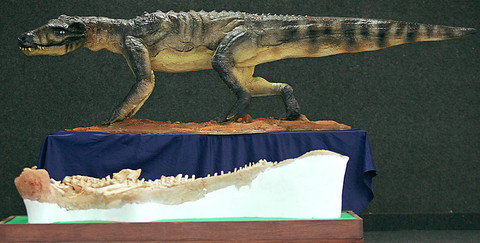Brazilian paleontologists last week proudly put on display a skeleton of a crocodile that roamed the earth in the time of the dinosaurs 90 million years ago.
The remains of the Baurusuchus salgadoensis were well preserved and included a complete head, said Pedro Henrique Nobre from the University of Rio department of geology, where the presentation was held.
"Finding a fossil is rare, but finding a collection of fossils [from the same animal] is even more rare and finding an intact head is extraordinary," Nobre said.

PHOTO: AP
The Baurusuchus was 3.5m long, and scientists estimate it weighed 400kg.
The paleontologists also presented a life-size reconstruction of what they believe the creature looked like.
The Baurusuchus remains were found 15 years ago in the western region of the state of Sao Paulo. It is the first time they have gone on display after years of restoration.
Unlike modern-day crocodiles, the Baurusuchus lived on land in a dry area. The location of the creature's nasal pasages indicated that it could not spend much time underwater, Nobre said.
The reptile had longer and more powerful rear legs than modern crocodiles, and the animal's teeth indicte that it was an active predator, he added.
The Baurusuchus belongs to the same family of ancient reptiles whose remains have been found in Argentina, southern Africa and the region between India and Pakistan. The scientists said their discovery suggests that an ancient land bridge linked South America to Indo-Pakistan.
The creature lived in the Cretaceous period, which lasted from 144 to 65 million years ago. It was the last period during which dinosaurs lived.

On April 26, The Lancet published a letter from two doctors at Taichung-based China Medical University Hospital (CMUH) warning that “Taiwan’s Health Care System is on the Brink of Collapse.” The authors said that “Years of policy inaction and mismanagement of resources have led to the National Health Insurance system operating under unsustainable conditions.” The pushback was immediate. Errors in the paper were quickly identified and publicized, to discredit the authors (the hospital apologized). CNA reported that CMUH said the letter described Taiwan in 2021 as having 62 nurses per 10,000 people, when the correct number was 78 nurses per 10,000

As we live longer, our risk of cognitive impairment is increasing. How can we delay the onset of symptoms? Do we have to give up every indulgence or can small changes make a difference? We asked neurologists for tips on how to keep our brains healthy for life. TAKE CARE OF YOUR HEALTH “All of the sensible things that apply to bodily health apply to brain health,” says Suzanne O’Sullivan, a consultant in neurology at the National Hospital for Neurology and Neurosurgery in London, and the author of The Age of Diagnosis. “When you’re 20, you can get away with absolute

May 5 to May 11 What started out as friction between Taiwanese students at Taichung First High School and a Japanese head cook escalated dramatically over the first two weeks of May 1927. It began on April 30 when the cook’s wife knew that lotus starch used in that night’s dinner had rat feces in it, but failed to inform staff until the meal was already prepared. The students believed that her silence was intentional, and filed a complaint. The school’s Japanese administrators sided with the cook’s family, dismissing the students as troublemakers and clamping down on their freedoms — with

As Donald Trump’s executive order in March led to the shuttering of Voice of America (VOA) — the global broadcaster whose roots date back to the fight against Nazi propaganda — he quickly attracted support from figures not used to aligning themselves with any US administration. Trump had ordered the US Agency for Global Media, the federal agency that funds VOA and other groups promoting independent journalism overseas, to be “eliminated to the maximum extent consistent with applicable law.” The decision suddenly halted programming in 49 languages to more than 425 million people. In Moscow, Margarita Simonyan, the hardline editor-in-chief of the